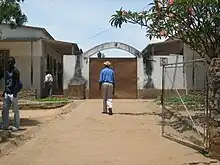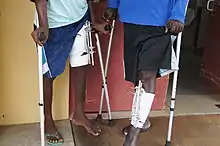
.jpg.webp)



Healthcare in Angola consists of a network of hospitals, clinics, and dispensaries.
Description
The National Health Service in Angola is run by the Ministry of Health, the Provincial Governments run Provincial Hospitals and the Municipal Administrations run Municipal Hospitals, Health Care Units and Posts. The Municipal Administrations are leading the primary healthcare network.
Services are free, since independence in 1975, but very limited in rural areas. Medicine is regulated by the General Health Inspection and the National Directorate of Health which manage the National List of Essential Medicines. Medicinal products are regulated by the National Pricing System. Tendering for medical products is run by the Centralized Medicine Purchase Authority which also distributes medicine.[1]
Staffing
Due to the length of the Angolan Civil War, nearly an entire generation of Angolans was not given the opportunity to receive any education. This has led to a dramatic decrease of health workers and added to the poor maternal health problem. In response to the shortage of health workers, Cuban physicians are currently working in the country to improve health overall, as well as to focus on improving maternal health.[2]
The health care system has felt the social effects of the War. Due to the large number of people who were unable to receive an education during the War, today, educated medical personnel, administrators, and other needed positions in the governmental system are not able to be filled. The population of Angola has lost nearly an entire generation of educated personnel. It was estimated in 2012 that there were about 0.08 physicians per 1,000 people in Angola.[3]
Operation
Some improvements were made after the end of the Civil War. According to UNICEF reports in 2005, 2% of the nation's public expenditures were allotted to health care. That number increased after 2005. Larger problems include the shortage of doctors, the destruction of health care facilities throughout the country, and disparities between rural and urban primary care availability.[4] Public spending on health decreased after 2014. The free public health system was still described as severely underfunded and understaffed in 2020. The medical technology and infrastructure is outdated and the system is difficult to access, so both locals and expatriates opt for private healthcare. Private healthcare insurance often has cover for emergency evacuation to better healthcare facilities in South Africa or other neighbouring countries.[5]
The Clínica Multiperfil in Luanda, although publicly owned, was granted special status by former President José Eduardo dos Santos, and is allowed to charge for care. Most of its patients are insured politicians and members of the military.
Hospitals cannot always provide prescribed medication and patients may have to buy this, and some medical supplies, privately.[6]
History
The healthcare system in Angola suffered considerably during the Angolan War of Independence (1961–1975) and the subsequent civil war (1975 – 2002). Healthcare facilities were dilapidated, equipment was not maintained, and medical supplies which are almost all imported were very scarce. Wealthier people could get treatment at private hospitals, but the public system barely functioned. The Government of Japan set up a grant aid project, the "Project for Improvement of Medical Equipment in Primary Health Facilities in Luanda Province", in 2000 with the intention of improving the 27 health centres there. This was followed by finance of almost 3 million yen for the planned reconstruction and repair of Josina Machel Hospital, the main specialist referral centre in the country. Procurement of medical supplies and equipment was, and still is, complicated by the fluctuations in the foreign exchange rate. [7]
Hospitals in Angola
The following is a partial list of hospitals in Angola. The best hospitals are located in the capital city, Luanda.[8]
Luanda
- Josina Machel Hospital, Luanda, 8°49′26″S 13°13′35″E / 8.823848°S 13.22651°E[9][10][11][12]
- Americo Boavida Hospital
- Lucrécia Paím Maternity Hospital, Luanda[13]
- Clínica Multiperfil in Luanda.[14]
- CSE - Rádio Nacional de Angola
- Clinica Girassol
See also
References
- ↑ "Pricing & Reimbursement- Angola". Lexology. 16 November 2018. Retrieved 25 December 2018.
- ↑ https://www.youtube.com/watch?v=mA1SnN4N_zo. Accessed 9, 2012.
- ↑ CIA Factbook April 9, 2012.
- ↑ www.unicef.org http://www.unicef.org/infobycountry/angola_54038.html. Retrieved April 30, 2012.
{{cite web}}: Missing or empty|title=(help) - ↑ "Healthcare in Angola". Allianzcare. 2020. Retrieved 23 July 2020.
- ↑ "Angola's state hospital poor people assume is private". BBC. 21 September 2017. Retrieved 21 July 2020.
- ↑ Hiruma, Yasuhiro. "Project for Improvement of Josina Machel Hospital" (PDF). jica.go.jp. Retrieved 21 July 2020.
- ↑ "Healthcare in Angola". Allianzcare. Retrieved May 18, 2020.
- ↑ Republic of Angola – Project for Improvement of Josina Machel Hospital jica.go.jp, (PDF; 387 kB) S. 11, retrieved 7 April 2020.
- ↑ Historia de la Salud – Hospital MARÍA PÍA historiadelasalud.blogspot.com, 27 January 2014, retrieved 8 April 2020 (in Spanish).
- ↑ Josina Machel Hospital hpip.org, retrieved 7 April 2020
- ↑ Republic of Angola – Project for Improvement of Josina Machel Hospital jica.go.jp, (PDF; 387 kB) S. 6–7, retrieved 7 April 2020
- ↑ Nimi, T.; Costa, D.; Campos, P.; Barros, H. (2019). "Sociodemographic Determinants of Caesarean Delivery in the Largest Public Maternity Hospital in Angola". Acta Médica Portuguesa. 32 (6): 434–440. doi:10.20344/amp.10409. PMID 31292024.
- ↑ "Angola's state hospital poor people assume is private". BBC. 21 September 2017. Retrieved 21 July 2020.
- ↑ "Blog Hospital Nossa Senhora da Paz, Cubal, Angola".
- ↑ "Diccionario médico de umbundu Hospital Nossa Senhora da Paz".
- ↑ "Adventist Directory, Locate Adventist Entities".